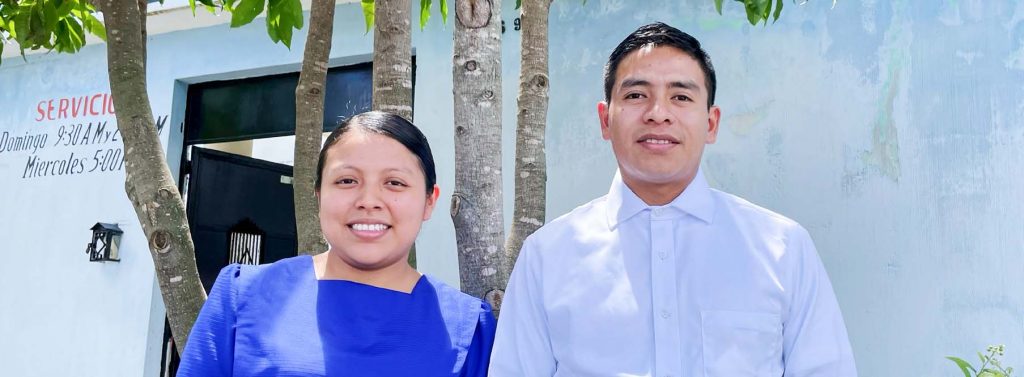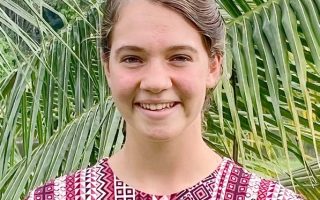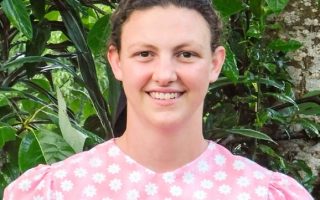A Day in the Life of Joy
It is a new morning, and I hurry down to my classroom, ducking under the electric fence that generally keeps the cows from entering the school. I am greeted by the second-grade girl that almost always arrives early. We enter the one-room adobe schoolhouse, and I check to make sure everything is ready to begin the school day. A few more students and Seño Florinda (the kindergarten to third-grade teacher) arrive, depositing their backpacks in their classroom. The curtain between our classrooms creates at least a visual barrier.
There are two other classrooms in another building beside the church where students from grades four to eleven study. The schoolroom becomes silent once more as the students run up to the church to join the others for a devotional. If I am not in charge of the devotional, I usually stay in my classroom making last-minute preparations or printing worksheets that I finished late the night before.
One of the greatest challenges of teaching here is the fact that there are not adequate math exercises included in the curriculum. This means that I, as the math teacher for grades two through eleven, spend many hours searching for or creating custom worksheets for my classes.
Happy shouts and running footsteps signal the return of the young students. I anticipate the much slower (and less enthusiastic) arrival of the eleventh graders. Their eyes grow wide at the sight of the lesson awaiting them on the whiteboard, and I must admit that internally I am equally alarmed. Trigonometry is not a subject that I ever studied, and now the challenge of learning and teaching it in my second language (Spanish) is overwhelming. They gratefully welcome my feeble efforts to explain the complicated concepts. When I admit that I am also stumped, they graciously tell me, “It’s okay, Seño Joy. We will learn together.” The class period ends, and they head back to their classroom to tackle their other subjects with their homeroom teacher, Profesor Arbin.
Chatter and giggles always indicate the very slow arrival of the eighth- and ninth-grade girls. These five young ladies were some of my first students when I began teaching three years ago. I remember my dismay that first year to discover that they did not know how to multiply or divide. Now I have the privilege of watching them successfully solve complicated algebra equations. The boring math lesson will occasionally be interrupted by suppressed giggles as we overhear something hilarious from one of the small students on the other side of the curtain. The end of this class period also indicates the beginning of recess. For thirty minutes the students will run off pent-up energy and fill growling stomachs with snacks, green mangos, or the foul-smelling green jocotes that they seem to enjoy so much.
Recess ends, and the third and fourth graders bounce into my classroom. They are an interesting mix as the two fourth-grade girls mostly missed the last two years of classes due to the COVID pandemic but were still passed to the next grade. As I explain the process of division to one student for what seems like the hundredth time, print off extra worksheets for the fast workers, listen to multiplication tables, answer questions, and review homework, I sometimes remember why I never wanted to be a teacher. However, seeing the delighted expression on their faces as they say, “Now I understand! It makes sense now!” is sufficient reward for the difficult days. Their departure is usually a bit slower than their arrival, as if competing to see who can become the most distracted on the way back to their classroom.
The fifth and sixth graders are the last group to arrive for math class. This class also presents the challenge of including one student who missed the last two years of school, but he tries his hardest to understand the lessons that his companions find simple. When he asks me in despair, “Seño Joy, why doesn’t anything stay in my head?” I have to wonder what the Guatemalan Department of Education was thinking when they mandated that every public-school student must pass to the next grade. If only he could understand that this disadvantage does not indicate stupidity. At noon, these students hurry to their homeroom where Seño Lorena will dismiss them for the day.
The school day is short, but this method allows the students to be available to help their families with the many tasks that are required for life in the mountains of Quiché.
I will spend the afternoon in my classroom preparing English lessons for the next day as I am also the English teacher for grades five through nine. Those classes are always very interesting as they are full of questions about my life in the States. “Is it city everywhere? Do you have to pay for water in your house? Do you have to work on the roads? What do you eat if you don’t have tortillas?” They struggle to pronounce the words Thursday, girl, and butterfly. I attempt to hide my amused smile, but a few observant students notice and don’t miss the opportunity to share a memory of when Seño Joy was learning to speak Spanish. We laugh about our mistakes and are grateful for the progress that has been made.
The work of a teacher is much more than just explaining academics. We have the tremendous opportunity to be a witness for Christ daily to each of these precious children. The value of a Christian school is summed up in the testimony of one of our students: “I would not have had the courage to become a Christian if I had to study at the public school.”
~ Joy Zimmerman
The Houses We Build
Houses in Guatemala are different from the one you probably live in right now. A Guatemalan house tends to be significantly smaller than the typical domicile of a Mennonite family in the States or Canada, even though the family living in it often has as many or more children! It is not so unusual to have a dozen family members living in a house the size of a single-wide mobile home.
The climate in “the Land of Eternal Spring” generally allows for a much more outdoor lifestyle and for simpler construction. In our area, a few of the poorest folks have houses made of rough-sawn planks and lumber with cheap tin roofs. But most of the poor households live in houses made of adobes—sun-dried mud bricks (cheap as dirt) made with a simple wooden form. These walls tend to be quite thick—ten inches or more—and do well at keeping out the heat. However, windows tend to be quite small, just one missing adobe to let in a bit of light and air. And of course, dirt walls are… dirty. Many adobe houses have clay-tiled roofs, though tin is also common.
A slightly better-off family may have a concrete floor or even concrete plaster on the adobe walls. But an increasing number of houses here are being constructed of concrete blocks, cement floors, and steel roofs. Some have even built concrete “palaces” with fancy embellishments or a second level. Unfortunately, nearly all the financing for this “housing boom” is derived from illegal migrants sending money back to Guatemala.
Sometimes it seems the “Guatemalan Dream” is to get to the United States and make “easy money” for several years, send funds back to build a nice house and perhaps buy a pickup truck, then move back and take it easy. Sadly, our native brothers are not immune to this temptation, and over the last two years, a couple of church members suddenly left for the States.
When a father is gone for two years (or longer), the children suffer, and the home will never be the same. They may end up with a nicer house, but the time lost with their family will never be recovered. Which is more important? A nice big house or a strong home?
While I can certainly encourage Guatemalans to have a decent roof over their heads and separate bedrooms for the parents, the boys, and the girls (which is not common in our area), should we be so concerned about how our house looks? After all, our earthly house will decay and eventually be destroyed. We ought to invest more in preparations for our housing situation in eternity.
The Apostle Paul spoke of this in his first letter to the Corinthian church. “For other foundation can no man lay than that is laid, which is Jesus Christ. Now if any man build upon this foundation gold, silver, precious stones, wood, hay, stubble; every man’s work shall be made manifest: for the day shall declare it, because it shall be revealed by fire; and the fire shall try every man’s work of what sort it is. If any man’s work abide which he hath built thereupon, he shall receive a reward. If any man’s work shall be burned, he shall suffer loss: but he himself shall be saved; yet so as by fire” (1 Corinthians 3:11-15).
I may not understand this passage completely, but some aspects seem clear. First, the foundation of the Christian life is Jesus Christ. Our salvation is based on faith in our resurrected Saviour. Any “house” of good works built on another foundation is doomed.
Second, Christians are expected to build upon this sure foundation. But we apparently can choose what and how to build, as we see multiple references to “man’s work.” Paul provides a “materials list” that includes three items of notable value and durability and three that are cheap and combustible. All the works we do as Christians fall into one category or the other. Verse 15 makes quite clear that these works do not earn our salvation, as the man is saved apart from his works. Obviously, it is better to build with gold, silver, and precious stones on the foundation laid for us. But this raises an equally obvious question. Which works—things that we do here on the earth—are works of gold, silver, and gems? I have wished for an exhaustive list of “works” and their respective values, but I now believe we have something much better; the Holy Spirit and plenty of instructions in other passages of Scripture.
Third, it is emphasized that “Every man’s work shall be made manifest” with no exceptions.
Fourth, it seems that the works of some (presumably Christians) will be burned even though their life was built upon the right foundation. And those Christians will miss out on the reward mentioned in verse 14. Will there be “rich” Christians ensconced in glittering mansions and “homeless” Christians living on the golden streets in Heaven? This is certainly one aspect I don’t understand about this passage.
But there are things we can understand. Using our time, energy, and talents for building the church and bringing the lost to Christ will be rewarded! Can you build better? Have we been building with straw and stubble? May God give us wisdom to build with gold and silver upon the Rock of Ages!
“Whosoever cometh to me, and heareth my sayings, and doeth them, I will shew you to whom he is like: he is like a man which built an house, and digged deep, and laid the foundation on a rock: and when the flood arose, the stream beat vehemently upon that house, and could not shake it: for it was founded upon a rock. But he that heareth, and doeth not, is like a man that without a foundation built an house upon the earth; against which the stream did beat vehemently, and immediately it fell; and the ruin of that house was great” (Luke 6:47–49).
~ Justin Zimmerman

Baptismal service in San Cristobal on September 25, 2022
Baptism at San Cristobal
On September 25, 2022, Francisco Grave and Andrea Calel were baptized at Iglesia Emanuel in San Cristobal. Lester Burkholder preached the baptism sermon, and Victor Ovalle performed the baptism. After the baptism service Sunday morning, we enjoyed a fellowship meal together. We enjoyed a table laden with beef steak and lots of other delicious foods, including a large assortment of beautiful doughnuts from Francisco’s store.
Francisco has a bakery and store in San Cristobal, a short distance from the church. Andrea works in a tortilla shop. She had a desire to live like her Aunt Lydia, who is a member in San Cristobal. We thank God for the influence godly people can have on their relatives and friends.
This young couple has been courting for a little more than a year but waited to be married until after they were baptized. Francisco and Andrea patiently went through the instruction class for baptism without complaining about how long it took. They are strong in the faith and have a sincere desire to serve the Lord in the church.
Please pray for these dear souls!
~ Lester Burkholder
The Home We Love
Some have mansions here below, and others—hovels, crude and low.
If here below you have a shack, rejoice, when even comforts lack.
If here below you have a tower, serve the Lord with all your power.
Someday, my friend, your house down here—of straw, or stone—shall disappear.
Your home above shall better be, prepared by Christ, for eternity!
If down here on the earth below, you seek the Lord, His will to know!
If in a mansion here below, with carpets soft, and lights that glow
Is where you sleep and where you dine, please listen now, oh friend of mine!
Your life below so soon is past; choose a mansion that shall last.
You can be sure, there’s a God above, who sees your heart, and what you love.
Your home above shall grander be, prepared by Christ, for eternity!
If down here on the earth below, you seek the Lord, His will to know!
If here below your house is poor, someday, my friend, you’ll have much more,
In that city grand, up above, if here below, the Lord you love.
If here below your house is cheap, do not love what you cannot keep.
Remember, friend, there’s a God above, who sees your heart, and what you love.
Your home above shall greater be, prepared by Christ, for eternity!
If down here on the earth below, you seek the Lord, His will to know!
If here below your house is nice—clean and simple, of modest price,
You stay warm, in peace you sleep; love the Lord, and His ways keep!
So build your house, strong and tight; eat and drink, sleep safe at night.
But remember, there’s a God above, who sees your heart, and what you love.
Your home above shall nicer be, prepared by Christ, for eternity,
If down here on the earth below, you seek the Lord, His will to know!
~ Anonymous
- Yolanda Martin
- Faith Pletcher
- Dustin Hartzler
Staff Changes
Welcome to Faith Pletcher. She is currently helping Lisa Dyck with domestics during the school construction in Oratorio, but plans are for her to eventually teach school after the building project is completed and she learns Spanish. She is from Bourbon, Indiana, and is a part of the Wisler Mennonite church.
We also recently welcomed Dustin Hartzler, from Shinnston, West Virginia. He is training to be the crew leader for the school construction project in Oratorio. He comes from the Shinnston Fellowship.
Yolanda Martin is helping the Dean Boll family in Santa Rosita for a short time. She comes from Halifax, Pennsylvania, and is a member of Victory Chapel. May your time in Guatemala be richly rewarding!
Prayer and Praise Items
- Pray for additional workers for the churches throughout Guatemala and for additional headquarters staff in Guatemala City.
- Pray for the upcoming General Institute on December 6-8, 2022. This is the first such event to be held by MAM in nearly three years.
- Praise God for good harvests for many Guatemalan farmers this year!
- Praise God for new believers!
Personnel Needs
We are thankful for the solid core of workers in our outpost teams and are praying for and seeking workers for the following positions:
- Business administrator, to coordinate mission efforts and oversee finances.
- House parents for mission headquarters, to oversee hospitality, serve other missionary families, and provide spiritual support for single workers.
- Young men for logistics support, building projects, and church and outreach work.
- Young ladies for domestic service, both at headquarters and in an outpost setting.
Please join us in prayer for these needs. If you are interested in serving or know someone who may be, please contact Brian Yoder ([email protected]) or David Martin ([email protected]).




